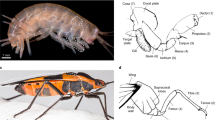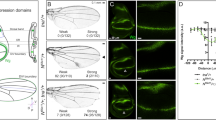Abstract
In Drosophila, genes controlling segmentation in the thorax and abdomen are clustered in one region of the genome known as the bithorax complex. Studies of the genetics of this complex suggest that loss of activity of a gene causes transformation of a particular segment to a more anterior one, mesothorax representing the ultimate transformation1. This transformation is well described for the epidermis, but it is not clear whether other segmentally arranged tissues are also transformed. The segmental ganglia are fused in Drosophila into a single compact mass termed the thoracic ganglion but the segmental organization of the nervous system is still apparent. There are discrete regions of neuropil, termed neuromeres, corresponding to the three thoracic segments: pro thorax, mesothorax and meta-thorax. A small terminal neuromere corresponds to the abdominal segments. Evidence is presented here that the leg motoneurones of each of the three thoracic segments are arranged in a segment-specific pattern in the thoracic ganglion. In mutant flies which have the metathoracic cuticle transformed to mesothoracic, the arrangement of the metathoracic leg motoneurones can be altered to resemble that of the mesothoracic leg motoneurones.
This is a preview of subscription content, access via your institution
Access options
Subscribe to this journal
Receive 51 print issues and online access
$199.00 per year
only $3.90 per issue
Buy this article
- Purchase on Springer Link
- Instant access to full article PDF
Prices may be subject to local taxes which are calculated during checkout
Similar content being viewed by others
References
Lewis, E. B. Nature 267, 565–570 (1978).
Mesulam, M.-M. J. Histochem. Cytochem. 24, 1273–1280 (1978).
Hanker, J. S., Yates, P. E., Metz, C. B. & Rustioni, A. Histochem. J. 9, 789–792 (1977).
Bacon, J. P. & Altman, J. S. Brain Res. 138, 359–363 (1977).
Power, M. E. J. comp. Neurol. 88, 347–409 (1948).
Lewis, E. B. Abstr. 16th Int. Congr. Ent. Kyoto, 161 (1980).
Lewis, E. B. Drosoph. Inf. Serv. 55, 208 (1980).
Palka, J., Lawrence, P. A. & Hart, H. S. Devl Biol. 69, 549–575 (1979).
Ghysen, A. Nature 274, 869–872 (1978).
Author information
Authors and Affiliations
Rights and permissions
About this article
Cite this article
Green, S. Segment-specific organization of leg motoneurones is transformed in bithorax mutants of Drosophila. Nature 292, 152–154 (1981). https://doi.org/10.1038/292152a0
Received:
Accepted:
Issue Date:
DOI: https://doi.org/10.1038/292152a0
This article is cited by
-
Transgenesis in rats: Technical aspects and models
Transgenic Research (1996)
-
Functional implications of the projections of neurons from individual labellar sensillum of Drosophila melanogaster as revealed by neuronal-marker horseradish peroxidase
Cell and Tissue Research (1992)
-
Developmental biology: Nervous excitement over insect muscle patterns
Nature (1986)
-
The function ofbithorax genes in the abdominal central nervous system ofDrosophila
Roux’s Archives of Developmental Biology (1986)
-
Domains of action of bithorax genes in Drosophila central nervous system
Nature (1985)
Comments
By submitting a comment you agree to abide by our Terms and Community Guidelines. If you find something abusive or that does not comply with our terms or guidelines please flag it as inappropriate.



